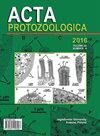Molecular Phylogeny of the Marine Planktonic Dinoflagellate Oxytoxum and Corythodinium (Peridiniales, Dinophyceae)
IF 1.2
4区 生物学
Q4 MICROBIOLOGY
引用次数: 1
Abstract
The dinoflagellate genera Oxytoxum and Corythodinium that account for more than fifty species are widespread in warm oceans. These genera have been considered synonyms and thecal plate designations varied among authors. Several planktonic and sand-dwelling genera have been placed within the Oxytoxaceae. We obtained the first molecular data based on small subunit (SSU) rRNA gene sequences of Oxytoxum and Corythodinium, including the type species (O. scolopax and C. tessellatum) and C. frenguellii and C. cristatum. The three species of Corythodinium branched together a strong support [bootstrap (BP) of 98%]. This formed a sister clade with moderate support (BP 75%) with O. scolopax that supported the generic split. Oxytoxaceae should exclusively remain for Oxytoxum and Corythodinium, as an independent group, unrelated to any other known dinoflagellate. Oxytoxum was characterized by spindle-shaped cells with an anterior narrow epitheca, an apical spine and little cingular displacement. Corythodinium exhibits relatively broad cell shapes, with wider epitheca and greater cingular displacement, and an obovate or pentangular anterior sulcal plate that noticeably indented the epitheca. This suggested the need of new combinations for species that were described as Oxytoxum and possessed the characteristics of Corythodinium.海洋浮游鞭毛藻Oxytoxum和Corythodinium的分子系统发育
鞭毛藻属Oxytoxum和Corythodinium在温暖的海洋中广泛存在,它们的种类超过50种。这些属被认为是同义词,在作者之间,这些板的名称各不相同。几个浮游和沙栖属被归入氧虫科。基于小亚单位(SSU) rRNA基因序列,首次获得了Oxytoxum和Corythodinium的分子数据,包括模式种(O. scolopax和C. tessellatum)和C. frenguellii和C. cristatum。三种柱头菌分枝在一起,支撑力(BP)高达98%。这一分支与支持属裂的猪尾黄形成了一个具有中等支撑力(BP为75%)的姐妹分支。Oxytoxaceae应该只保留Oxytoxum和Corythodinium,作为一个独立的类群,与任何其他已知的鞭毛藻无关。氧虫的特征是梭形细胞,具有狭窄的前上皮,顶端棘和少量的带状移位。扁桃体细胞形态较宽,上皮较宽,呈较大的环形位移,前沟板为倒卵形或五角形,上皮明显凹陷。这表明需要新的物种组合,这些物种被描述为Oxytoxum并具有Corythodinium的特征。
本文章由计算机程序翻译,如有差异,请以英文原文为准。
求助全文
约1分钟内获得全文
求助全文
来源期刊

Acta Protozoologica
生物-微生物学
CiteScore
2.00
自引率
0.00%
发文量
8
审稿时长
>12 weeks
期刊介绍:
Acta Protozoologica - International Journal on Protistology - is a quarterly journal that publishes current and comprehensive, experimental, and theoretical contributions across the breadth of protistology, and cell biology of Eukaryote microorganisms including: behaviour, biochemistry and molecular biology, development, ecology, genetics, parasitology, physiology, photobiology, systematics and phylogeny, and ultrastructure. It publishes original research reports, critical reviews of current research written by invited experts in the field, short communications, book reviews, and letters to the Editor.
 求助内容:
求助内容: 应助结果提醒方式:
应助结果提醒方式:


